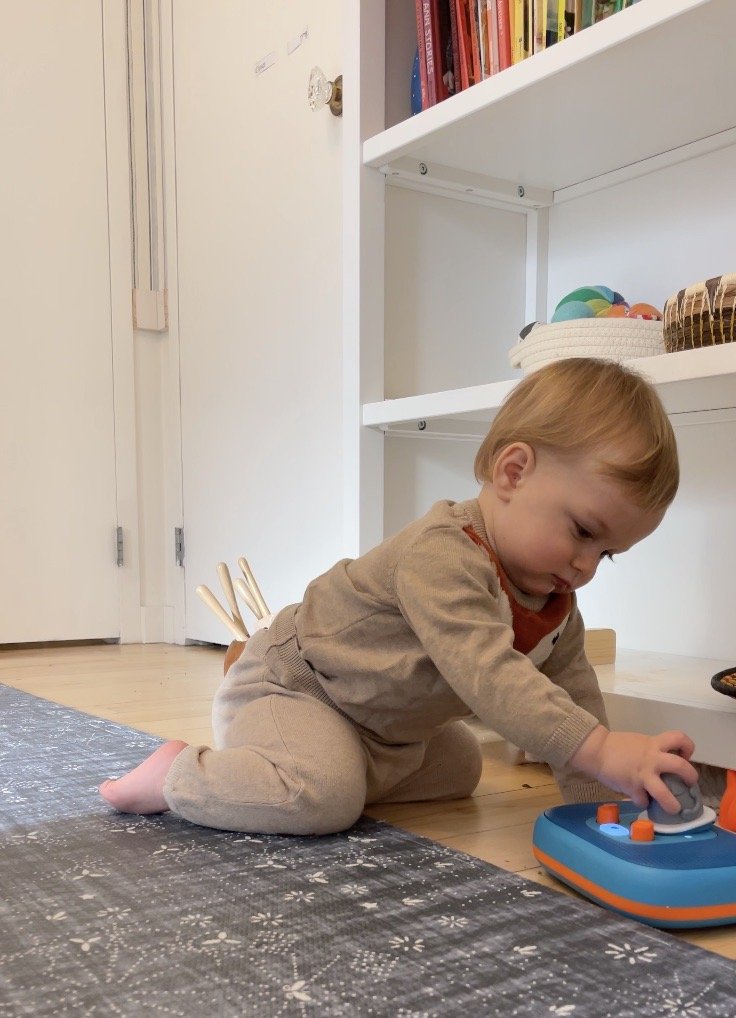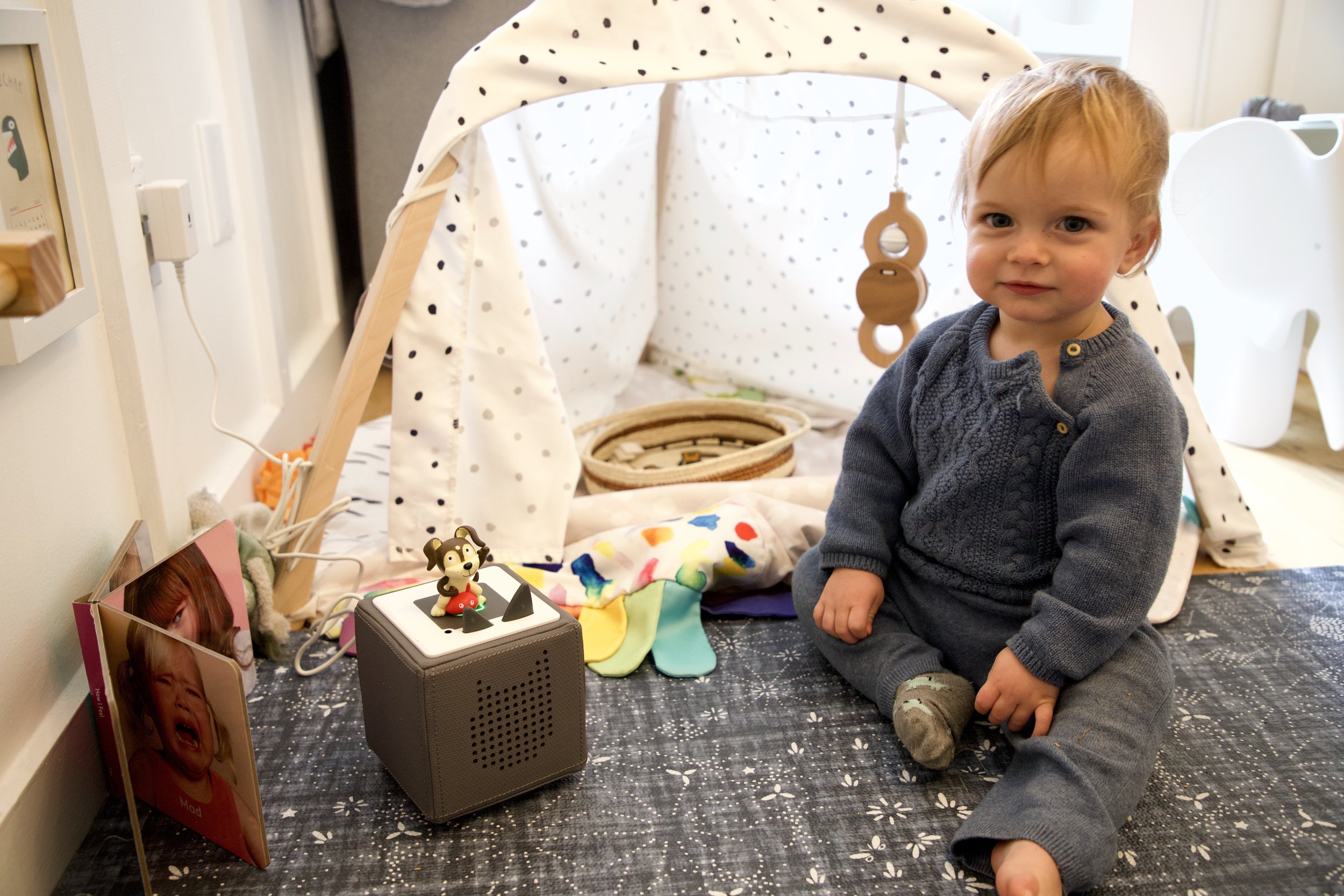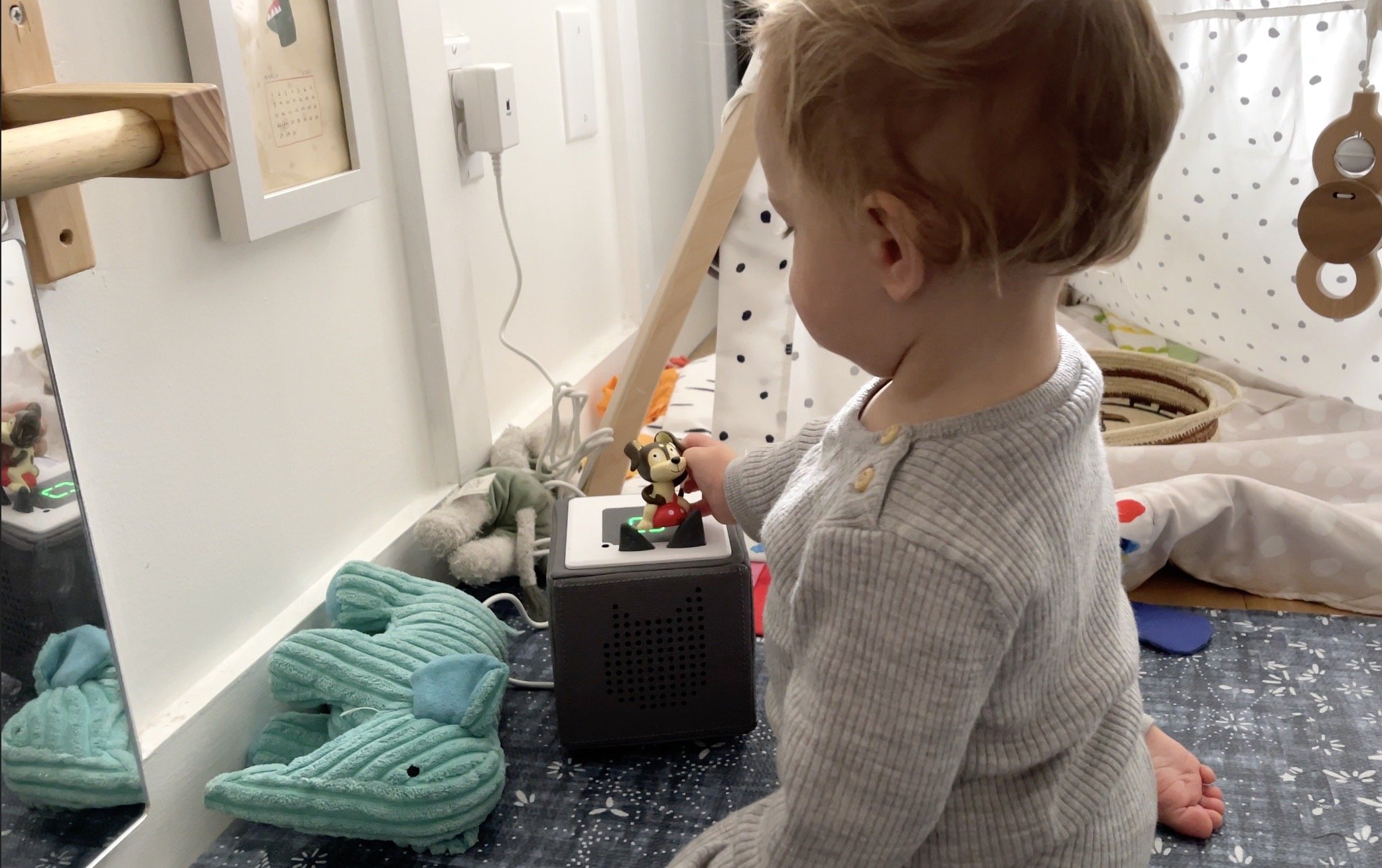Toniebox v. Jooki for a One-Year-Old
This post may contain affiliate links, which means I may earn a small commission if you buy through my link but does not change your price.
This review is unsponsored and not gifted. We bought both the Jooki and Toniebox for our son for his first birthday.
UPDATE: Looking for a review of the Yoto as well? Check out this post!
Yitzchak loves music and I am not amazing about playing it. I knew I wanted more music in his life so I decided for his first birthday to get him a kid’s music player. From the beginning, we were deciding between the Jooki and the Toniebox. We decided on the Jooki but then returned it and switched to the Toniebox. I will go through why below.
Toniebox v. Jooki Player
Both the Toniebox and the Jooki player allow the child to play music using figurines. With the Jooki player there are also little tokens that can be used.
The Toniebox has two types of figurines, called Tonies: preprogrammed and creative Tonies. Most of the preprogrammed Tonies are stories. For example, there is a Winnie the Pooh one with a compilation of Winnie the Pooh stories. They have a few with music including the playtime puppy Tonie that the Toniebox comes with. The playtime puppy Tonie includes standard children’s songs such as the ABCs, I know an old lady who swallowed a fly, and the Old Man is Snoring. The figurines mostly are in the shape of what they are playing. So, for example, the Winnie the Pooh Tonie is in the shape of Winnie the Pooh.
The Jooki comes with one of the tokens preprogrammed, but it is programmed to some adult music on Spotify. I have no problem with playing adult music (it is what I usually do) but I did find this a bit strange for a children’s music player. The other tokens and figurines are all “create your own.” These can be created either by linking a Spotify playlist or adding MP3 files on their desktop app. The figurines for the Jooki are no specific characters but are a ghost, knight, etc.
Another comparison of the Toniebox v. Jooki is the audio player itself. The Jooki looks more like a standard Bluetooth audio player. It is hard plastic in dark blue and orange. The Toniebox is available in multiple colors. It is cube-shaped so it looks less like other music players would. Both take headphones, the Toniebox through a standard headphone jack and the Jooki through a converter.
Both the Jooki and Toniebox work similarly in terms of functionality. You put the figurines (or tokens) on top and they play. The Jooki has a nest for the token or figurine to go whereas the Toniebox has a flat top and they stick on with a magnet. The Jooki requires you to be a bit more exact in where and how you put the figurine on than the Toniebox.
Why we initially chose the Jooki
We initially chose the Jooki player over the Toniebox because we imagined mostly wanting to play our music. We have some favorite music we wanted available to Yitzchak. We didn’t really picture playing the storytime books much. We also preferred the idea of having a smaller number of tokens you can program as opposed to the huge collection of Tonies you can end up with.
I also preferred how the Jooki looked to the Toniebox. The Jooki looks more like an actual audio player whereas the Toniebox looks more like it was designed for kids. The Jooki has dials that look like how you change the volume on any music player. The Toniebox has you squeezing the ears to change the volume. It looked like the Jooki might be a bit smaller too.
Finally, I liked how the Jooki had tokens. Though I planned to use the figurines at first I thought once he was older the tokens might be good for travel, etc.
Why we returned the Jooki and switched to the Toniebox
We were so excited with our decision to get the Jooki but even on day one we were having problems. My husband uses Spotify but I use Apple Music. I downloaded the Jooki app hoping to set up a few playlists. It has a pretty terrible rating on the App store which after use doesn’t surprise me. I was unable to get music on the figurines. I followed the instructions (and downloaded Spotify) and it just wasn’t working. They claim it works with Spotify Free but I am skeptical. I also realized though I didn’t want ads on his music.
My husband (who has an Android) then downloaded the app. He was able to get it to work, but we quickly realized this would mean he couldn’t play music at the same time as the Jooki was playing. This is something to keep in mind if you don’t have a family account! We got the music playing and the Jooki was working, but ran into troubles later.
Once we had the music on Yitzchak was able to proficiently take off the Jooki figurine and he put it back on a couple times.
A few days after getting the Jooki set up we were set to go away for a week. We brought the Jooki, excited for him to be able to use it. However, we soon realized (as makes sense) it only works with wifi. I kind of imagined the figurines downloaded the playlists but I guess that would be a copyright issue. Without wifi, the player at this point was less useful than a Bluetooth speaker. Now, there are ways to use it without wifi but it requires adding MP3 files onto the figurines from the computer, but I will get to that.
Realizing the Jooki needed wifi I tried to connect it to the local wifi which is done through the app, but my phone could not find the Jooki. My husband’s phone couldn’t either. I am not sure if this is a bug making it work on only one wifi but it makes the device pretty bad for travel. I also tried connecting it to my computer since I wanted to add offline music on it. Neither the desktop app nor the in-browser app could find the Jooki player. I presume if I had been on our home wifi we would be able to find it on the desktop app, add MP3 files, and have the Jooki player work offline. However, at this point we had already decided to throw in the towel. Of course, we may have been doing something wrong. There probably are ways to make it work but this is a reflection at the very least on the ease of use. I do think Jooki is a newer and smaller company and maybe they haven’t worked out the software as well.
Also, even within the last couple weeks since we bought the Jooki I was realizing a change in Yitzchak which made the Toniebox more appealing. He has become more interested in rereading books over and over. Of course, I will continue to read and reread books to him but it made me realize he would probably like the Toniebox stories.
Thoughts on the Toniebox
It was probably partly because of our frustrations with the Jooki player but when I set up the Toniebox I immediately loved it. The app is better for sure. It has a similar connect to wifi setup but then you can immediately put their preprogrammed Tonies on and they play music. Once they have initially been placed on connected to wifi they can play offline. This is so nice for travel. The Toniebox comes with the playtime puppy Tonie which plays popular children’s music and nursery rhymes. We did a create your own bundle too where we added several storytime Tonies and two creative tonies that we can add our own music to.
Having the playtime puppy Tonie all set up with music though has been wonderful. We are only introducing it at first so Yitzchak can get used to how to put the Tonie on and take it off and the cause and effect of that. Once he has mastered that we will introduce another. I am not a big kid’s music person but he loves the songs and I don’t mind them.
In terms of the creative Tonies it was so much easier than adding your own files to the Jooki. You can easily add on the app itself versus the Jooki where you have to do it on a computer. You can mix MP3 tracks with recordings that can be done on the app. Since we are raising Yitzchak bilingual we are going to both do some of Yitzchak’s Hebrew music (which we actually have a cd of anyway so it will be easy to add) and some recordings of my husband reading in Hebrew. They also have a small free library that can be added to the creative Tonies.
We introduced the Toniebox to Yitzchak about a week and a half after he turned one and he figured it out right away. It was slightly easier for him to put the figurines on than with the Jooki because the reader is less exacting on how you put it on. He still takes it off more than he puts it on, but within the first week he has gotten a lot more proficient.
The Jooki v. Toniebox Bottom Line
In the end I am very glad we switched to the Toniebox. It is a lot easier for both of us to use. I’ve also actually come to love the idea of getting audiobooks on there. My big dream is to be able to get Hebrew audiobooks, but we will see if that ever happens! We got multiple audiobooks of books we have including Peter Rabbit and Elmer.
If you’re a big music family and you want to play music you do not own, the Jooki might be better for you. You can add any music to the Toniebox but I do not believe there is a way to do it through a streaming service so you have to own it. All of the ones that come with the Jooki are make your own figurines as opposed to the Toniebox where all creative Tonies are extra. That said, if you are using your own audio (as opposed to wanting to stream on Spotify) I found it was way easier to add tracks to the Toniebox. Overall, my biggest complaint with the Jooki surrounds their software including the app and desktop app. There is a chance that will improve at any time!
I also know there are other players out there. A lot of people love the Yoto player. I think the Yoto player looks fantastic for slightly older kids. If Yitzchak was a year and a half older I would probably get the Yoto. However, the cards would not make sense at this age. He still mouths things and I worry they would get ruined plus he would struggle to put them in the player. As a disclaimer, both the Jooki and the Toniebox are also recommended for ages 3+. Though I would be surprised if most of the Tonies or Jooki figurines actually failed a small objects choke tester, this is definitely something I would only recommend with supervision!
Do you have either? What are your thoughts?





